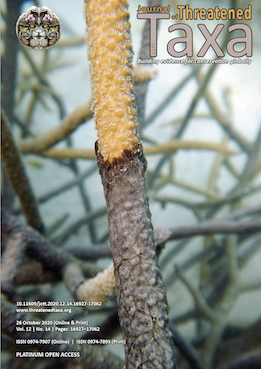Butterfly species richness and diversity in rural and urban areas of Sirajganj, Bangladesh
DOI:
https://doi.org/10.11609/jott.4796.12.14.16971-16978Keywords:
Abundance, ecosystem, family, forest, natural gardening, landscape, riversideAbstract
An appraisal of butterfly species diversity study was conducted in four selected parts of Sirajganj District, Bangladesh, as a part of an ecological research. The study was conducted from March 2015 to April 2016. A total of 19,343 butterflies belonging to five families and 12 subfamilies was recorded. A random sampling of forest, riverside rural, and urban areas in Sirajganj District revealed the presence of 65 butterfly species, dominated by Lycaenidae (37%) over Nymphalidae (33%) followed by Pieridae (19%), Hesperiidae (7%), and Papilionidae (4%). Butterfly fauna in Bangabandhu Sheikh Mujib Jamuna Ecopark (BJEP), compared with the percentage of other study sites, was very high (Hs= 4.03) and the percentage of hedge species was relatively higher (45%) than that of improved grassland and forest interior species. The relative abundance of the butterflies varied with the site, month, and family significantly. Considering the landscape of Sirajganj, steps to enhance riverside natural gardening should be adopted to maintain butterfly diversity and sustain the ecosystem services derived from them.
References
Chazdon, R.L. (2008). Beyond deforestation: restoring forests and ecosystem services on degraded lands. Science 320: 1458–460.
Chowdhury, S., T. Hesselberg, M. Bohm, M.R. Islam & U. Aich (2017). Butterfly diversity in a tropical urban habitat (Lepidoptera: Papilionoidea). Oriental Insects 2157–8745.https://doi.org/10.1080/00305316.2017.1314230
Evans, W.H. (1932). The Identification of Indian Butterflies. Bombay Natural History Society, Bombay, 454pp.
Kehimkar, I. (2013). The Book of Indian Butterflies. Bombay Natural History Society, 497pp.
Kunte, K. (2000). Project life scape. Resonance 5: 86–97.
Larsen, T.B. (2004). Butterflies of Bangladesh - an annotated checklist, IUCN Bangladesh Country Office, Dhaka, Bangladesh, 104pp.
McKinney, M.L. (2008). Effects of urbanization on species richness: a review of plants and animals. Urban Ecosystems 11: 161–176.
Oostermeijer, J.G.B. & C.A.M. van Sway (1998). The Relationship Between Butterflies and Environmental Indicator Values: Tools for Conservation in a Changing Landscape. Biological Conservation 86: 271–280.
Pollard, E. (1991) Monitoring butterfly numbers, 87–111. In: Goldsmith, B. (eds) Monitoring for Conservation and Ecology. Conservation Biology, Vol 3. Springer, Dordrecht i-xv+275pp. https://doi.org/10.1007/978-94-011-3086-8_6
Rahman, M.S., I.K.A. Haidar, A.K. Neogi, M.A.U. Hasan, M.M. Rahman & S.M.S. Imam (2016). First record of six butterfly species in Bangladesh. Journal of Insect Biodiversity and Systematics 02(3): 373–380.
Raupp, M.J., P.M. Shrewsbury & D.A. Herms (2010). Ecology of herbivorous arthropods in urban landscapes. Annual Review of Entomology 55: 19–38.
Sharma, N. & R. Singhvi (2017). Effects of chemical fertilizers and pesticides on human health and environment: a review. International Journal of Agriculture, Environment and Biotechnology 10(6): 675–679.
Wix, N., M. Reich & F. Schaarschmidt (2019). Butterfly richness and abundance in flower strips and field margins: the role of local habitat quality and landscape context. Heliyon 5(5): e01636. https://doi.org/10.1016/j.heliyon.2019.e01636
Published
Issue
Section
License
Authors own the copyright to the articles published in JoTT. This is indicated explicitly in each publication. The authors grant permission to the publisher Wildlife Information Liaison Development (WILD) Society to publish the article in the Journal of Threatened Taxa. The authors recognize WILD as the original publisher, and to sell hard copies of the Journal and article to any buyer. JoTT is registered under the Creative Commons Attribution 4.0 International License (CC BY), which allows authors to retain copyright ownership. Under this license the authors allow anyone to download, cite, use the data, modify, reprint, copy and distribute provided the authors and source of publication are credited through appropriate citations (e.g., Son et al. (2016). Bats (Mammalia: Chiroptera) of the southeastern Truong Son Mountains, Quang Ngai Province, Vietnam. Journal of Threatened Taxa 8(7): 8953–8969. https://doi.org/10.11609/jott.2785.8.7.8953-8969). Users of the data do not require specific permission from the authors or the publisher.





